Structure and Scale of the Imperial Palace of Liao Dynasty’s upper capital Confirmed for the First Time
From:Chinese Archaeology NetWriter:Date:2015-03-04
The site of Liao Dynasty’s upper capital is located at the southeast of Lindong town, Bairin Left Banner, Inner Mongolia Autonomous Region. The site consists of two parts, the north of which is Imperial city, and the south is Han city, with a “日” shape and an area of about 5 square kilometers. The wall of Imperial city is well preserved, with an irregular square shape, and the imperial palace is located in the middle of the imperial city. From July to October in 2014, Inner Mongolian second archaeological team, Institute of Archaeology , Chinese Academy of Social Sciences and Inner Mongolian Institute of Cultural Relics and Archaeology formed a joint archaeological team, to conduct the archaeological exploration and excavation to the wall and west gate of Imperial Palace, cleared up an area of about 1000 square meters. Main remains include the walls, the west gate, the north wall of the “west courtyard”, and etc, to primarily define the scale and structure of the imperial palace.
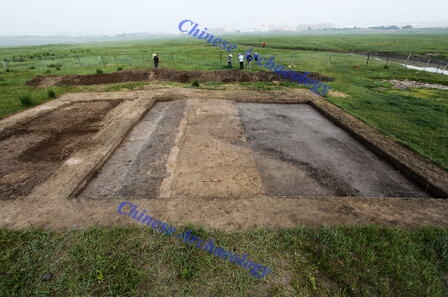
view of the west part of the north wall of imperial palace (from east to west)
The Wall of Imperial Palace
The wall of the imperial palace was badly preserved. Most of the wall was buried under the ground, except part of the north was humped, left unrecognizable. Through the excavation and dissection of the north, south and west wall of the imperial palace, it can be known that the wall was rammed with earth, divided into the wall body and foundation trench. The height of the wall body above the ground is from 0.3 meter to 2.0 meters. The bottom width of the north and west wall is about 2.6 to 2.9 meters, with yellowish rammed earth. The bottom width of the south wall is about 6.6 to 6.8 meters, with beige rammed earth. Both sides of the wall foundation were rammed with revetment, and the moat might be found outside the wall. The traces of pillars were distributed in the equally spaced position on the side wall, and at the bottom, a number of post holes were found distributed in the equally spaced position as well, which is related to the construction of the wall, being as an important archaeological discovery. According to the remains, the wall was built in Liao dynasty, with part of supplement rammed earth; was abandoned in Jin dynasty, with houses built above the wall remains.
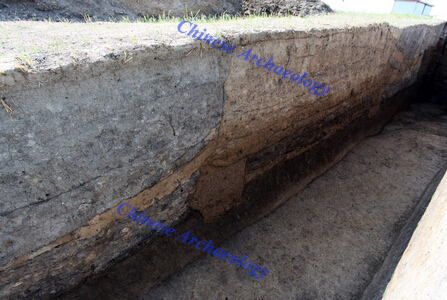
the section of north wall of imperial palace (from north to south)
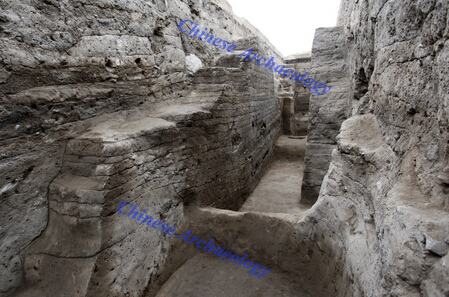
the section of south wall of imperial palace (from south to north)
West Gate of Imperial Palace
The west gate is located in the middle of the west wall of Imperial Palace, just opposite to the west gate of Imperial city. Archaeologists explored to find out there is a path connecting two gates. The gate consists of abutments on both sides and the gateway. The abutments are in bad preservation condition, a single gateway was constructed inside, with 6.4 meters’ width. Stone gate-blockers (Jiangjunshi), difu stone ground beam, pavement, post holes and other building components were found inside the pathway. According to the traces and relics, the gate had experienced at least two large scale constructions in Liao dynasty.
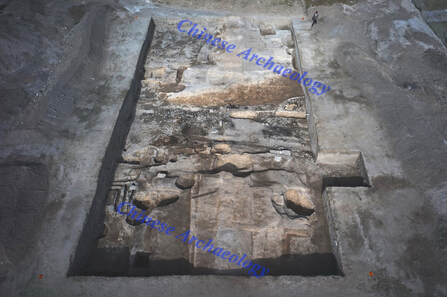
Aerial photo of the west gate remains of Imperial palace
The range of the Imperial Palace
According to the exploration, the palace is located in the middle east of the imperial city, rectangular, about 740 meters’ wide, 770 meters’ long. Apart from the north wall, the location and length of the east, west and south were corrected or confirmed for the first time in the archaeological work of this year.
North Wall of the “West Yard”
A large court yard was found at the west of the imperial palace, which was historically called “West Yard” site. It is rectangular, about 240 to 270 meters’ wide, 360 to 390 meters’ long. The abandoned palace wall was completely covered by the north wall of the west yard, constructed by different layers of earth. The left height is 0.8 meter to 1 meter, and the bottom is about 5.3 to 5.5 meters’ wide. The mound is about 0.3 to 0.5 meter’s thick, and the soil is loose, burying a large number of relics. Outside the wall, there is a ditch. According to the remains, the construction time of the wall is no earlier than the Late Jin dynasty.
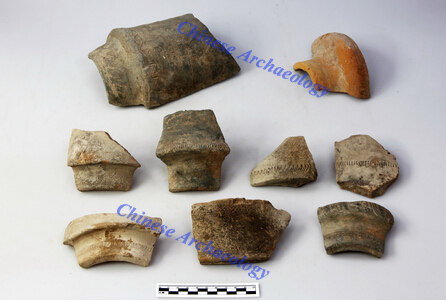
tiles unearthed from the north wall reamins of imperial palace
Glazed tiles, eaves tiles, round tiles, fragments of flat tiles, porcelain roof ridge animals and other building components; as well as chinaware, copper coins, copper seals, copper mirrors, ironware, bone ware with dragon pattern, stone fragments carving with characters and etc were unearthed. They provide important basis for dating and basic materials for establishing the chronology sequence of the site of Liao Dynasty’s upper capital.
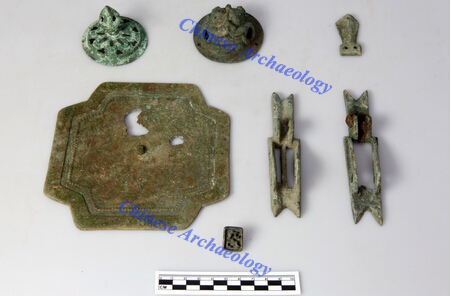
bronzewares unearthed from the west gate remains of imperial palace
This excavation is a significant result of Liao Dynasty’s upper capital, clarifying the construction practice, the shape and structure, and the period of the imperial palace wall of Liao Dynasty’s upper capital. The location of the west gate, the shape and structure and the evolution of the west gate; and the general scope of the imperial palace were known for the first time. The structure and the time of the “west yard” wall were confirmed. In addition, the fact that the construction of the “west yard” is the same place of the abandoned palace wall shows that the urban layout had been changed much from Liao dynasty to Jin dynasty. (Translator: Wang Jue)

